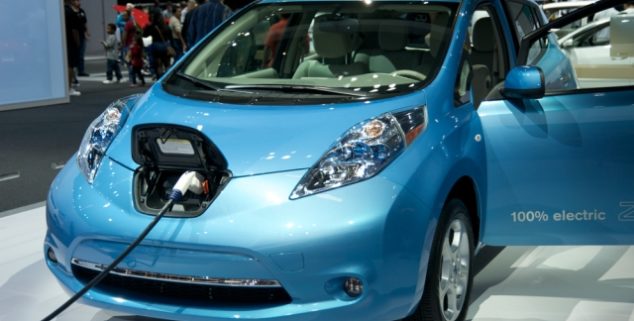News
Electric vehicles in the fast lane
 An electric vehicle gets a battery recharge at the L.A. Auto Show. Photo: Juan Camilo Bernal)
An electric vehicle gets a battery recharge at the L.A. Auto Show. Photo: Juan Camilo Bernal) By the time today’s infants are in their early 30s, gasoline-powered cars that aren’t hybrids could be a rarity in California.
That’s the goal of California policy makers who are doing their best to phase those cars out by 2050 and replace them with zero-emissions vehicles like electric cars, plug-in hybrids and hydrogen fuel cell vehicles.
Vehicles that run on fossil fuels generate nearly 40 percent of California’s harmful greenhouse gas emissions.
Toward that end, Gov. Jerry Brown signed an executive order in January calling for 5 million zero-emissions vehicles on the road by 2030 – a giant increase from the 350,000 on the road today.
He also proposed a $2.5 billion initiative that will bring 250,000 vehicle charging stations and 200 hydrogen fueling stations to the state by 2025.
The reason is to reduce carbon emissions that are causing devastating changes to weather systems here and around the globe. In California, some of those effects are warmer winters, less snowfall, hotter summers and more wildfires.
Vehicles that run on fossil fuels generate nearly 40 percent of California’s harmful greenhouse gas emissions.
In about 20 years, the Perry believes zero-emissions vehicles could be as common as smart phones are today.
“Climate change is, if not the greatest issue of the day, up there as one of the top three,” said F. Noel Perry, venture capitalist and founder of public policy think tank Next 10. “California is moving forward to reduce emissions to make a contribution.”
Next 10 recently released a report by Beacon Economics showing that California is on track to meet Brown’s goals. In about 20 years, the Perry believes zero-emissions vehicles could be as common as smart phones are today.
Countries including China, France, the United Kingdom, India and Norway, have announced plans to phase out gasoline and diesel cars.
“There is a movement across the globe a movement away from internal combustion vehicles,” Perry said. “It seems like China is really moving forward in terms of them having the greatest number of selections in Chinese vehicles.”
One of the biggest factors holding Californians back from getting electric cars is the limited number of charging stations. The state has only 16,549 public charging stations now or about .05 outlets per zero-emissions vehicle.
Fifty percent of the cost of electric vehicles is driven by the battery cost and battery costs have been declining substantially year after year.
Other major factors slowing the spread of electric and other similar cars are cost, range, charging time and the number of selections in the showroom, Perry said.
But the performance of the cars is steadily improving. “The models that are coming out today, the marquis one being the Chevy Bolt are more moderately priced vehicles in the $30,000 range with the ability to travel over 200 miles a charge,” said Matt Stanberry, vice president of market development for Advanced Energy Economy, an organization of businesses working to make energy secure, clean and affordable. “That is one of the things consumers have been looking for.”
Fifty percent of the cost of electric vehicles is driven by the battery cost and battery costs have been declining substantially year after year.
Most Californians are not aware of what zero-emissions vehicles are out there and don’t know how they work.
California sweetens the pot by providing incentives of $1,500 and $2,500 to those who buy most electric cars and $5,000 to those who buy a hydrogen fuel cell vehicle. The federal government also offers a tax credit of up to $7,500.
Stanberry said California should offer an even higher incentive to increase more purchases. “The prices of vehicles are coming down rapidly but for the next 5-10 years, upfront costs are higher than for an internal combustion engine,” he said. “We need to look at expanding the incentives.”
Ryan McCarthy, science and technology policy advisor to the chair of the California Air Resources Board, said research shows that most Californians are not aware of what zero-emissions vehicles are out there and don’t know how they work. “It’s very confusing for people,” he said.
“Tesla’s high-end costly models get much of the press coverage and people aren’t as aware of the many other types of cars out there, including Tesla’s own Model 3 priced in the $30,000s.”
The state strives to inform the public about options with its DriveClean California website (driveclean.ca.gov). The site, which will be updated this year, explains how the cars work, the types of technologies available and fuel efficiency ratings for the different models. The nonprofit Veloz plans to start a new widespread consumer awareness campaign to highlight electric cars.
“There’s research that once people have test driven these cars and see that they’re more fun to drive than conventional cars and that they’re convenient to plug into your house, they like them and buy these cars,” McCarthy said.
—
Ed’s Note: Includes Tesla 3 projected cost, 18th graf.
Want to see more stories like this? Sign up for The Roundup, the free daily newsletter about California politics from the editors of Capitol Weekly. Stay up to date on the news you need to know.
Sign up below, then look for a confirmation email in your inbox.

Leave a Reply